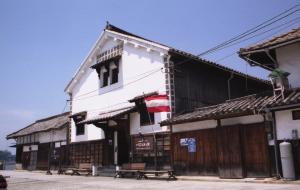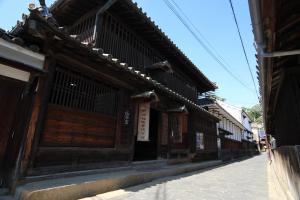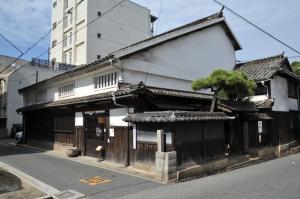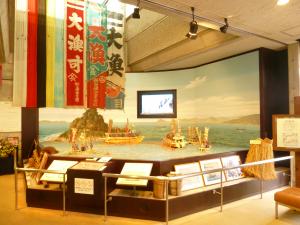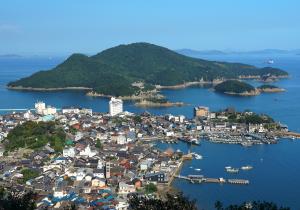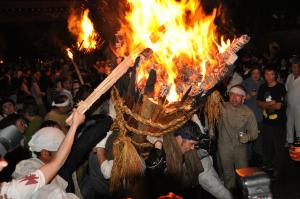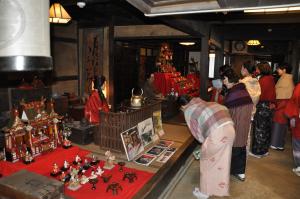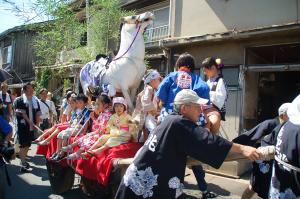本文
Introduction to Tomonoura
History of Tomonoura
Tomonoura is a port town that has flourished in Setouchi (Seto Inland Sea area) since the period of Manyoshu (literally, collection of ten thousand leaves; anthology of Japanese poetry in around 7th to 8th century) as a strategic harbor for maritime traffic. The major reason was its importance of being centrally located in the Seto Inland Sea where seamen could wait for favorable tides in order to navigate.
Around the late Heian period, port towns developed in various areas around Japan due to increased trade with East Asia and the growth of a monetized and mercantilist economic system, and Tomonoura also prospered from the gate of Gionsha (current Nunakuma Shrine) toSeki-cho as a commercial town on par with Kyoto.
In the days of Mori and Fukushima, Tomo Castle was built on Shiroyama (castle hill), and in 1576, Ashikaga Yoshiaki, the last shogun of the Muromachi period escaped to Tomo, and attempted to revive the shogunate (Tomo shogunate).
After Tomo Castle was abandoned in 1609 prior to the Ikkoku Ichijo Rei (Law of One Castle per Province), Tomonoura became a port-centered town populated with merchants, blacksmiths, Homeishu (medicinal liquor) brewers, etc., and fishermen. Also, when Korean envoys arrived in Japan, they resided at Taichoro, a reception hall of Fukuzenji Temple in Tomo, praising the view from the temple as“the most beautiful scenery in the region east of Korea.”
Tomo enjoyed over one thousand years of prosperity as a port town but the prosperity ended due to the opening of the Sanyo Main Line and the advancement in automobile access in modern times. Nowadays, the town’s old maritime atmosphere and townscape are being thought of as heirlooms to be treasured.
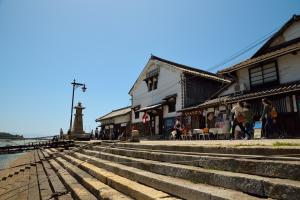
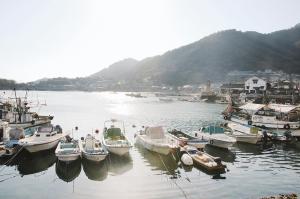
Joyato (five harbor facilities)
In the town of Tomo, the harbor showcases traces of an earlier modern age including Joyato (all-night street light), Gangi (stair-like boat landing), Funabansho (old coast guard station) ruins, Ohato (big breakwater), and ruins of Tadeba (old dock) on which ship maintenance and repair were performed.
Joyato standing at the tip of the great Gangi in Nishimachi is a typical lighthouse called Torodo, which was donated by the people of Nishimachi in 1859. The magnificent tower exceeding 10m from the foundation platform is the tallest among existing Joyato lights of the Edo period. With a prayer for navigational safety, stone frames are hung on a supporting pole inscribed with the words “Konpira-dai-gongen” on the south face and “Tosho Gion-gu” on the north face (deities of maritime safety).
At the port, there is a stair-like boat landing called Gangi, which enables loading and unloading irrespective of whether the tide is high or low. Today, such a large-scale Gangi can be seen only in the port of Tomo.
Funabansho for surveillance of ships passing through the Seto Inland Sea was built on a hill at the tip of Taigashima at the beginning of the Edo period. Even now, you can see the high stone walls perfectly stacked without any gaps by cut stone (Kirikomihagi), a structure that was built by Tomo rural magistrate Ogino Shinemon Shigetomi.
The early modern port town with traces of a medieval port, in which most of the structures are left intact, is recognized as the only cultural heritage harbor city in Japan.
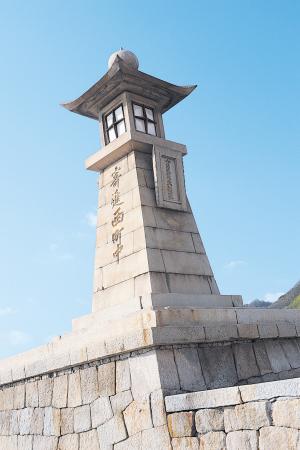
Irohamaru Exhibition Building
The Irohamaru Exhibition Buildingis a shore warehouse that was built on reclaimed land in the Edo period, and nearby are Gangiand Joyato,which are early modern harbor facilities. It feels as though we are slipping backin time to the Edo period.
The Irohamaru Exhibition Building is wooden, two-storied, and gabled with an entrance on the gable sideand Hongawara-buki (formal tile roofing), and is considered to be a building from the mid-19th century, when the townscape proved a spectacular view, bristling with earthen storehouses taking on a similar form in the direction of Gangi at the Tomo Port. Groups of earthen storehouses with an entrance on the gable side facing the seawere commonly seen in port towns in the Edo period, but existing examples are only a precious few today.
Although some modifications have been made to the exhibition building, it is well preserved, using traditional bamboo roofing boards, white-plasteredexterior walls bearing no exposed pillars, and baseboards planked to be resistant to rain.
At the Exhibition Building, Sakamoto Ryoma’s belongings from Irohamaru that sank off the shore of Tomo, a diorama showing how the ship sank, and so on are on display.
The currentIrohamaru Exhibition Buildingwas registered as a national cultural property in 1997.
Residence of the Ota Family (national important cultural property) and ruins of Tomo Shichikyo-ochi (prefectural historic site)
The residence of the Ota family contains a cluster of building structures from one of the most famous merchants in Tomonoura, who prospered as a brewer and seller of Homeishu from the middle of the Edo period through the Meiji period. Homeishu is a medicinal liquor made mainly from glutinous rice and brewed using shochu (distilled spirits), 16 kinds of Japanese and Chinese herbs, and other ingredients. This was Tomo’s specialty product during the Edo period.
The building consists of nine ridges: centering on the main house (mid-18th century), kitchen, south Homeishu brewery (early 18th century), north Homeishu brewery (1788), west storehouse (1789), east Homeishu brewery (1795), house for steaming rice, new storehouse, and north earthen storehouse (early 19th century). In addition to the grand row of building structures, the designs of the checkerboard-patterned earth floor and wickerwork ceiling of the main house, and dice-like Namako walls (tiled with plaster joints resembling the shape of a sea cucumber (namako in Japanese) of storehouses, reflect a regal bearing that such an important merchant would deserve.
Currently, these buildings are central to the historic townscape of Tomo and have been restored to their late Edo period to early Meiji period existence through preservation and repair.
The name of the ruins of Tomo Shichikyo-ochi (the exile of seven nobles from Kyoto) was taken from the fact that seven nobles including Sanjo Sanetomi in the group of Sonnojoi-ha (supporters of the doctrine of restoring the emperor and expelling the barbarians)made a visit to the residence of the Ota family and their second house Chosotei during the last days of the Tokugawa shogunate. The preserved records indicating a visit on August 23, 1863 and during July 18 and 20, 1864 recall the tense situation of the last days of the Edo period.
Ioji Temple and Taishiden
Torinzan Ioji Temple is a temple of the Shingon sect, and it is said that the temple was founded by Kukai in 826, where the principal object of worship is a “wooden standing statue of Yakushi Nyorai” (important cultural property designated by the prefecture). Additionally, the wooden sitting statue of Amida Nyorai (important cultural property designated by the city), wooden sitting statue of Jizo Bosatsu, wooden standing statue of Juichimen (eleven-faced) Kannon, and so on are excellent works of the Muromachi period, indicating that the temple was at its peak of prosperity in the Muromachi period.
The current main hall was built under the sponsorship of Mizuno Katsutane, who was the lord of the Fukuyama-han in 1685, and the Niomon Gate and bell tower were also built in the Edo period.
On the mountainside behind Ioji Temple is Taishiden, which is said to have been originally located on the grounds of the temple and relocated after the World War II in the Showa period. Although there is no literature showing the age of construction, it is considered to be the early 1700s according to its style. From here, you can enjoy the view of Tomo Port and Setouchi islands.
Philipp Franz Balthasar von Siebold, German physician and botanist working for the Dutch East India Company, also praised its beauty because Taishiden located halfway up Mt. Ushiroyama is a place of scenic beauty. Siebold climbed here to collect plants and insects.
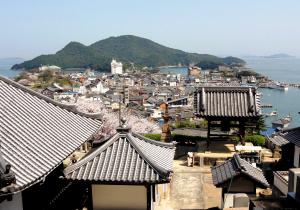
Enpukuji Temple
Enpukuji Temple was called Shakado in the Muromachi period, and located on the south side of the present day Nunakuma Shrine, but was relocated to its current spot around 1610, and given the name Enpukuji Temple. Before the Warring States period, this island frequently became a battle site as a strategic military post. Over Taigashima Castle during the period of the Northern and Southern Dynasties, each military battled fiercely for Tomo.
In the Edo period, it became a regular accommodation for higher-level officials of Korean envoys as a scenic location with a view of the islands of the Seto Inland Sea as well as Shikoku. Also, Chinese and Japanese poetry gatherings and haiku (short form of Japanese poetry) gatherings were frequently held as a stage for various cultural exchange. On the grounds of the temple, there is also a monument of Basho’s haiku.
The wooden Hengaku (name tablet) of this temple’s title at that time “Nanrinzan” displayed in the main hall was produced based on calligraphic writing that was left by the Korean envoy scribeHwa-amin 1711. Also, Rai Kyohei, who was Rai Sanyo’s educator and reputed to be the greatest calligrapher in the Rai family, named the room at the back of the main hall Kyomeiro and left his calligraphic writings about the room. Today, its Hengaku is displayed in the room.
This room is a treasure trove because we can feel the stage for cultural exchange of bygone days while enjoying the beautiful scenery of Tomonoura.
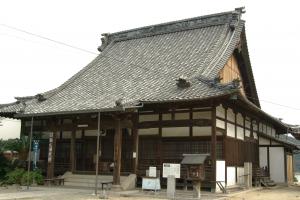
Taichoro (Fukuzenji Temple)
Fukuzenji Temple is an ancient temple that is said to have been founded during the Tenryaku era (947 to 957) in the Heian period, and is considered to have the longest history in Tomonoura. Originally, it was called Kannondo, and after it was reconstructed in 1610, it came to be called Fukuzenji Temple as it is today.
Taichoro was built as a reception hall during the Genroku era (1688 to 1703) in the Edo period, and was used as a public guesthouse, which stood on a stone wall facing the sea commanding a beautiful view of the Seto Inland Sea. Particularly, the Korean envoys dispatched from Korea each time a new shogun took control stopped in the Tomo Port, and most visited Taichoro, which served as a historical stage for international exchange.
In 1711, eight Korean envoys highly praised the view from Taichoro, and officer Yi Bang-won left his calligraphic writing “nitto daiichi keisho (the most beautiful scenery in the region east of Korea).” In 1748, chief envoy Hong Gye-hui named the reception hall Taichoro, and his son Hong Kyung-hae also left calligraphic writing of his name.
As calligraphic writings and Chinese poetry left by the Korean envoys were extremely impressive, the writings were made into wooden print blocks in the Edo period by Kan Chazan and others who hoped that they would be known by many people. These print blocks are still displayed in Taichoro, which gives us an impression of bygone days of international exchange.
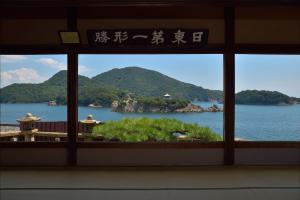
Ryoma’s Hideout in Masuya Seiemon Taku
On April 23, 1867, Irohamaru, a ship from the Kaientai (Maritime Support Fleet) including Sakamoto Ryoma on board and borrowed from the Ozu-han, collided with the Kishu-han’s battleship Meikomaru near present day Mushima, in Okayama Prefecture. The crew of the Irohamaru transferred to Meikomaru, towing the heavily damaged Irohamaru. They headed for Tomo Port, which was well-equipped with harbor facilities, but the Irohamaru sank on the way to the port. Following this, for four days after arriving in Tomonoura, Ryoma and other Kaientai members lodged at Masuya Seiemon Taku, the residence of a shipping agent, while the members of the Kishu-han lodged at Enpukuji Temple. Negotiations were conducted at facilities halfway between both accommodations, including the residence of former town official Uoya Manzo and Taichoro of Fukuzenji Temple. Following negotiations, Ryoma and the Kaientai were able to receive a large sum in reparations from the Kishu-han. This situation became known as the “Irohamaru incident.” Sakamoto Ryoma, whose life had already under threat by the shogunate at that time, stayed at Masuya Seiemon’s residence, using the name Saidani Umetaro.
The residence of Masuya Seiemon has passed on the story that “Sakamoto Ryoma stayed at the time of the Irohamaru incident,” but the exact spot had not been identified for many years. In 1989, as a result of an investigation by local volunteers of the ceiling of the building based on the legend, “Sakamoto Ryoma stayed and hid in a room in the attic.” Only one ceiling board could be removed, but a secret room was discovered. The room was left untouched and it was heavily covered in dust and in a state of disrepair. There were also no stairs to climb up to the attic. Now, it has been recreated and is open to the public.
Fukuyama-City Tomonoura Rekishi Minzoku Shiryoukan
Taking a cue from research by local volunteers and collection activities that started in 1977, Fukuyama-City Tomonoura Rekishi Minzoku Shiryoukan was built on the hill of the Tomo Castle ruins as a commemorative event for the 70th anniversary of Fukuyama City. In the museum, historical materials spanning ancient times through the early modern age, folk materials related to Otebi and Oyumi Shinto rituals, etc., are on permanent display, and it is familiar under the nickname “Shiomachi no yakata (house for awaiting a favorable tide).” Also, special and planned exhibitions present unique and popular shows based on themes of history, culture, and folklore of Setouchi centering on Tomonoura.
When you stand at the Tomo Castle ruins on a low hill of Fukuyama-City Tomonoura Rekishi Minzoku Shiryoukan, you can view the semicircular harbor and its facilities and also the islands designated as Tomo Park, a place of scenic beauty, including natural breakwater Sensuijima, Bentenjima, Tamatsushima, and Tsugarushima.
The scenic landscape is part of the Setonaikai National Park, the country’s first national park. Rai Sanyo expressed it as Sanshisuimeisho (a place of outstanding natural beauty). When you look far into the distance, the Shikoku mountains with clouds hanging on their summits fill your eyes and the calm and magnificent natural landscape praised by a Korean envoy as the most beautiful scenery in the region east of Koreaopens up before you. The appeal of Tomonoura is not only its historical heritage but also its cultural landscape which splendidly fuses with the natural landscape.
Tomonoura Tourist Information Center
The Tomonoura Tourist Information Center located in front of the Tomonoura bus stop offers current tourist information for sightseeing in Tomonoura.
Find out about recommended tourist spots, restaurants, accommodations and famous sights used as inspiration for “anime” scenes. You can also pick up maps in multiple languages, including English, Chinese, and Korean. Free Wi-Fi spots are also available for up-to-date information.
Postcards, Homeishu, and many other souvenirs specific to Tomonoura are also available.
If you want to know more about Tomonoura, a tour guide (“Tomonoura Shiomachi Guide”) who can provide information on Tomonoura’s history, culture, filming locations, and more is recommended. (Reservations required.)
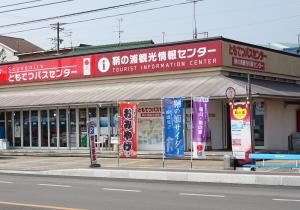
Nunakuma Shrine
Nunakuma Shrine, originally known as Shikinaisha (a shrine listed in the Engishiki laws), has been handed down through the ages since time immemorial, but the shrine’s original name lost use during the Edo period. In 1875, Gionsha and Watasusha positioned in the grounds of the current Nunakuma Shrine merged and came to be called Nunakuma Shrine. The enshrined deities are Owatatsuminokami (maritime safety) and Susanoonomikoto (perfect health).
Since ancient times, the shrine has attracted religious faithful, and a large number of important cultural properties remain as proof. What draws the most attention among the important artifacts is the Nunakuma Shrine Noh stage, which is a national important cultural property. It is said to have been originally established at Fushimi Castle in Kyoto by Toyotomi Hideyoshi who admired Noh very much, and on the occasion when Fukuyama Castle was built, it was transferred from the second shogun TokugawaHidetada to Mizuno Katsunari, the first lord of the Fukuyama-han (clan domain). This Noh stage was portable so that it could be easily split apart and moved, and is considered to be very rare as it could be erected and used as needed even on a battlefield. Katsusada, the third lord of the Fukuyama-han donated the Noh stage and Noh masks to this shrine that were, as legend has it, treasured by Hideyoshi. In 1738, the stage was permanently re-constructed as a fixed stage, but Noh afficionados still think of it as Japan’s only existing portable type Noh stage.
In addition to this, stonework, building structures, and traditional events, such as Oyumi (bow) and Otebi (fire) Shinto rituals, still popular today remind us of the prosperity of Tomo of bygone days.
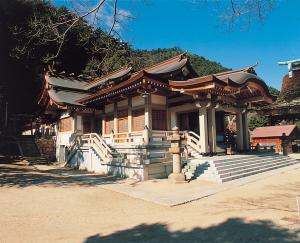
Ankokuji Temple
Bingo Ankokuji Temple is one of the Ankokuji temples that were established across Japan by order of Ashikaga Takauji in 1339.
Konpoji Temple, which was originally established by Muhonkakushin (Hotto Kokushi), in conjunction with Shakado (Buddhist sanctum) that was built in 1273 and followed by Amida Sanzon-zo (the image of the Amida Triad) a year later, is the predecessor of Bingo Ankokuji Temple. The outstanding buildings of the Kamakura period and Buddhist statues are filled with the long history of Ankokuji Temple.
In the Muromachi period, the name was changed to Ankokuji Temple, which declined with the end of the Muromachi shogunate, but was revived by Mori Terumoto and Ankokuji Ekei. Unfortunately, the main hall located behind Shakado was destroyed by fire in 1920.
Shakado designated as a national important cultural property maintains the appearance of the Buddhist sanctum of the Kamakura period, in which Mokuzo Amida Nyorai oyobi Ryowakiji Ryuzo (wooden standing statues of Amida Nyorai and two flanking attendants, important cultural properties), and so on are laid in state. The entire surroundings of the grounds are designated as a Hiroshima Prefecture historic site under the name of Bingo Ankokuji Temple, in which Karesansui (dry landscape garden) that was created in the Muromachi period has been passed down up to the present.
This ancient temple having diverse cultural assets teaches us about medieval history and culture on a nationwide scale.
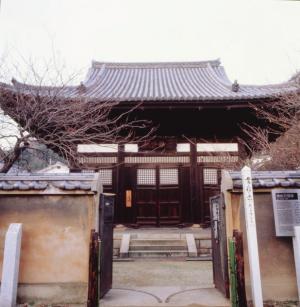
Sensuijima Island and Bentenjima Island
[Sensuijima Island]
This island approximately 6km around floats off the shore of Tomo Portabout 5 minutes by town ferry, and it is said that the origin to the name of the island is from its eternal beauty where even Sennin (a benevolent spirit or Taoist immortal) is completely mesmerized.
On the island where the nature of ancient times remains, five hiking trails have been groomed, and the Senningaoka Observatory on the west side commands a beautiful sunset view that was selected as one of the 100 best sunsets in Japan. Also, a campsite, beach, salt farm, and other leisure facilities as well as Kokumin Shukusha (public lodge) and other accommodations are available.
You can also seefive-colored (blue, red, yellow, white, and black) rocks called Goshikiiwa, a rarity in Japan.
[Bentenjima Island]
This uninhabited island located between Tomonoura and Sensuijima Island is also known as Hyakkanjima Island.
Benzaiten, a guardian deity for fishermen is enshrinedin thevermilion-lacqueredlandmarkBentendo.
The stupa standing nearby is engraved with the name from the era of the Kamakura period, which is among the oldest age-dated ones in Hiroshima Prefecture, and it has been designated as a prefectural important cultural property.
Every May, fireworks light up the nightsky over Bentenjima Island, and illuminate the sea surface.
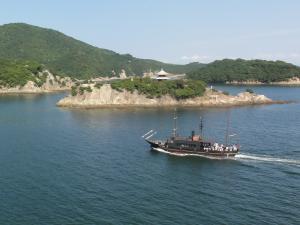
Tomonoura Taiami Sea Bream Netting Festival
The sea bream netting festival is an early summer tradition in Tomonoura. Taiami (sea bream netting) is a traditional fish-catching method that has been handed down for over 380 years.
The Seto Inland Sea known for the beauty of its many islands, indented coastline and moderate depths, is the perfect habitat for both young fish and adult fish due to the abundance of food in association with complicated tidal currents, large tidal variations, and temperate waters.
Fishermen in areas around the sea once caught sea bream approaching the shore by putting up stake nets in coastal areas, but they found another way to ensure a haul by taking their hunt to the sea bream offshore and driving them into nets. This is called “Taiami” applying the Shibariami (a kind of purse seine) fishing method.
At the Tomonoura Taiami Sea Bream Netting Festival, barrel drums and the Tairyobushi song wishing for safe passage and a good catch echo along the coast, and Otohime (sea goddess), a messenger of Benzaiten dances a “good catch” prayer dance. On board a boat, you can view this 380 years old traditional fish-catching method.
By the Shibariami fishing method, using a large-mesh seine net to drive the sea bream with another net called a “bag net” to catch sea bream, two master boat draggers move their boats in parallel, and as the boats move closer together and draw the nets, the sea bream are driven into the nets and hauled up.
In 2015, the Tomonoura sea bream Shibariami fishing method was designated as an intangible folk cultural property by Fukuyama City.
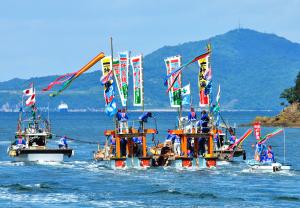
Otebi Shinto Ritual (municipal intangible folk cultural property)
The Otebi Shinto Ritual is a fire festival to purify the sites that Mikoshi (miniature shrines) passes through with flames of torches, performed prior to Mikoshi Togyo (procession) of Susanoonomikoto enshrined in Nunakuma Shrine.
Fire is set by three large torches (Otebi) 4.5m in length and approximately 150kg in weight, which are made by fixing Koematsu (pine) splints with a green bamboo cut into eight parts and eight sacred needle junipers and binding them with ten horizontal ropes and three vertical ropes, and one small torch (Kotebi) approximately 50cm in length.
At 6pm, a drum to start the festival is beaten by a local boy dressed in white, and at 7pm, a second drum is beaten to greet Susanoonomikoto. At 8pm, with a third drum, a sacred flame is transferred from the back of the main shrine to the small torch before the altar, and the three large torches are fired one by one. Then, they are carried up the flights of steps to the hall of worship and paraded valiantly.
This festival continues over a long period, starting with the Otebi Shinto Ritual on Saturday close to June 4 according to the lunar calendar, passing through Togyo to Otabisho (facility serving as a temporary destination of miniature shrines) of Taigashima on the 7th and Kangyo (return) from Otabisho on the 14th, and then ending with Goshinno (enshrining) on the 18th. In times past, a market called Gionichi was set up and crowds gathered in the town of Tomo.
Main festivals of Tomonoura
○ Early February: Oyumi Shinto Ritual
This New Year’s event follows the traditions and rituals of the ancients is held at Nunakuma Shrine to rid the world of demons from the past year and pray for the purity of the new year by shooting evil spirits with bows and arrows. It is Fukuyama City’s intangible folk cultural property.
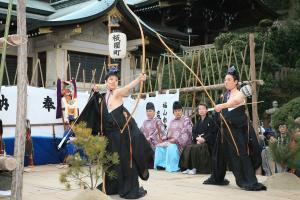
○ Late February to mid-March: Tomo Townscape Doll Festival
Shops, ryokan (Japanese style inns), and machiya (traditional wooden townhouses) on the streets of Tomonoura exhibit Hina dolls having been handed down generation after generation. You can see treasured Hina dolls that were created in the Edo period through the Meiji period.
○ Early to mid-May: Tomonoura Taiami Sea Bream Netting Festival
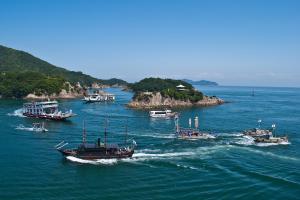
○ Last Saturday of May: Fukuyama Tomonoura Bentenjima Island Fireworks Display
At this seasonal tradition that signals the beginning of summer in Setouchi, fireworks create an atmosphere unique to Tomonoura. Before the display, local residents and children perform traditional Japanese “Aiya-bushi” entertainment.
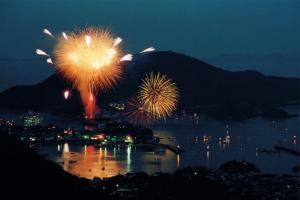
○ June 30: Chinowakuguri
This Shinto ritual is a summer purification rite held at Nunakuma Shrine on June 30. It is believed that sin, impurity, disaster, and plague are exorcised and purified by passing through this ring of miscanthus (Chinowa).
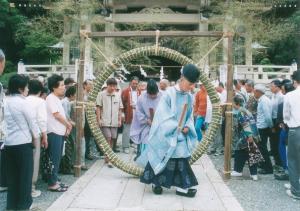
○ Night before the second Sunday of July: OtebiShinto Ritual
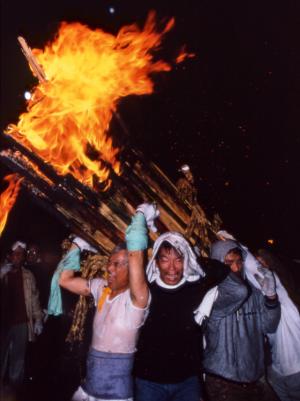
○ August: Togyo and Kangyo-sai Festival of Yodohime Shrine
It is commonly known as Dango-matsuri (rice dumplings) Festival, and Hira no Nage Mikoshi (carrying of miniature shrines) is well-known.
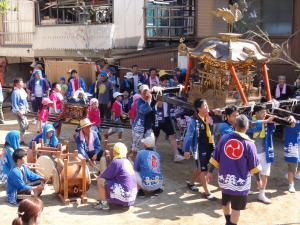
○ September (Friday, Saturday, and Sunday close to August 11 according to the lunar calendar): Chosai (autumn festival)
During this annual festival of Watasu Shrine, a gorgeous float called Chosai is carried around by townsfolk.
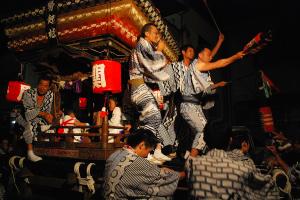
○ September (Sunday close to August 1 according to the lunar calendar): Tomonotsu hassaku no umadashi
Wishing for the birth of children and their healthy growth, Hassaku no uma (a white dummy horse on a platform) with children onboard caravans throughout the town.
○ First Saturday and Sunday of December: Fuigo Festival
This is the festival of Kogarasu Shrine, a guardian deity for blacksmiths in Tomo. On the eve of the festival, nightstalls hawk their food, drink and souvenirs.


